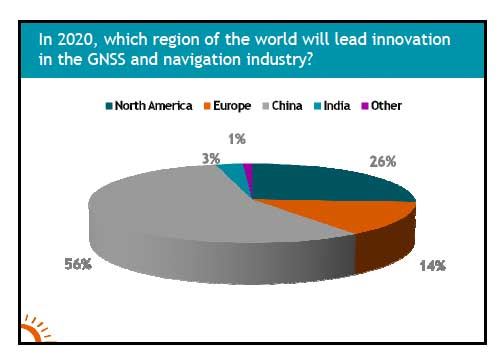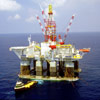
The high-precision GNSS industry should expect to see industry consolidation and a scramble for new markets and innovations as prices for high-end chips and modules continue to slide, experts told attendees at a ION GNSS+ panel discussion in Tampa, Florida, last week (September 11, 2014).
The falling prices could strain R&D budgets, they noted, but could also create opportunity as high-end receivers come within reach of emerging industries like self-driving cars, unmanned aerial vehicles, and are even incorporated into consumer products.
The high-precision GNSS industry should expect to see industry consolidation and a scramble for new markets and innovations as prices for high-end chips and modules continue to slide, experts told attendees at a ION GNSS+ panel discussion in Tampa, Florida, last week (September 11, 2014).
The falling prices could strain R&D budgets, they noted, but could also create opportunity as high-end receivers come within reach of emerging industries like self-driving cars, unmanned aerial vehicles, and are even incorporated into consumer products.
Co-chaired by Glen Gibbons, Inside GNSS editor, and Gavin Schrock, editor of xyHt magazine, the panel featured five speakers from innovator GNSS manufacturers and Gian Gherardo Calini, head of market development, European GNSS Agency (GSA) , addressing the topic, “High-Precision GNSS: What Will It Look Like in 2020? (Or, Is the Sky Really Falling?).”
Representing the GNSS manufacturing community were the following individuals: Ivan Di Federico, chief strategy officer and executive vice-president, Topcon Positioning; Jonathan Davis, director of Geospatial GNSS product marketing, Trimble Navigation Ltd.; Bernhard Richter, GNSS business director, Leica Geosystems; Jan Van Hees, director of business development, Septentrio and Altus Positioning Systems; and Shaowei Han, co-founder, president, and CEO of Wuhan Navigation and LBS, Inc.
Richter made the challenge clear. He told the standing room–only audience that the industry was experiencing an overall slippage in prices of 5 to 7 percent annually. Richter’s figures were somewhat more pessimistic than those of Calini, but both men saw the trend continuing if the industry didn’t change its approach to the high-precision market.
“We’ve seen about a 10 percent price erosion in some segments in the last three years,” Richter said, naming strong competition from China and new entrants as factors.
Without new markets or a new strategic approach to the market segment by manufacturers, Richter predicted, there would be a 40 percent decrease in profits and a 30 percent decrease in R&D spending in the next eight years
Under this gloomy scenario, which assumed a “business as usual” approach, “In 10 years we will not be profitable,” he told the audience. To meet the challenge the industry needs continuous innovation, Richter said, including further miniaturization and a “tighter integration” of microelectromechanical systems (MEMS) inertial technologies.
“You’ll never fit the precision antenna into an iPhone, but everything else you will be able to fit into the iPhone. The computers will be powerful enough, the chipsets will be small enough,” Richter said.
Calini said that agriculture, driven by the need to produce more with limited resources, would support long-term growth. He predicted total revenue would increase even though prices overall would fall — buoyed in part by the higher-margin agricultural receivers. As a result he anticipated global industry revenue of $1.04 billion next year rising to just under $2 billion by 2020.
Should the prices fall far enough, high-precision manufacturers could find themselves with rich opportunities in “pro-sumer” products — overlapping consumer and professional market segments —where the number of potential sales could reach the millions, offsetting to a degree the drop in prices.
“An iPhone with high precision chip will become true!” said Shaowei Han, co-founder, CEO and president of Wuhan Navigation and LBS, Inc.
But for that to happen, he said, the price of modules would need to drop to about $3.50 each with chips that cost a fraction of that.
“If you don’t drop the price, you cannot have those numbers,” Han said.
$20 Chips, $100 Modules?
The entry of China into the market may be one of the biggest factors in what happens next. Han’s recently launched firm is taking direct aim at high-precision equipment prices. He predicted that chip prices would fall to $20 with the price for high-precision modules plunging to $100 by 2020.
“We drive costs down,” Han said. “That is our mission.”
Di Federico said that he did not expect to see chip prices fall to $20 in the next six years because of the need to maintain the necessary quality.
“I don’t think it will happen that fast,” he said. But 20 years later, he added, “we have to be able to produce a $20 chip set. “
Di Federico agreed that high-precision chips will eventually be integrated into consumer electronics and he said he expected to see an iPhone with a precision chip eventually. By 2020, the mass market will start to expect precise positions on everything, he added.
Most of the panel agreed that thedistinction between professional users of high precision equipment and general consumers would diminish in the future. Moreover, more sources of data, including new GNSS signals, will be incorporated into new devices, enabling high-precision positioning even indoors.
Some of the new applications that emerge from all this change could be quite unexpected. Calini mentioned several, including semi-autonomous and autonomous driving, congestion management (lane-level accuracy), parking applications and management (car-width accuracy), advanced driver assistance systems, and port traffic management & approach and docking of ships
Sometimes the emergence of new high-precision applications occurs rapidly. In China, for instance, Han pointed out that government mandates for automated testing of driver’s license applicants in China, accompanied by a corresponding adaption by driver education schools, caused the volume the volume of real-time kinematic (RTK) GNSS units sold in China to from 30,000 in 2011 to several hundred thousand units this year.





